The Story of Ometecuhtli and Omecihuatl
Reading Time: 7 min
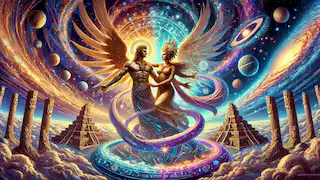
About Story: The Story of Ometecuhtli and Omecihuatl is a Myth from mexico set in the Ancient. This Descriptive tale explores themes of Wisdom and is suitable for All Ages. It offers Cultural insights. The creation myth of the Mexica gods, Ometecuhtli and Omecihuatl, whose unity and balance shape the cosmos.
In the sacred cosmos of ancient Mexica mythology, life did not begin with a single spark but rather with a balanced unity—a duality that brought all existence into being. This is the tale of Ometecuhtli and Omecihuatl, the Lord and Lady of Duality, gods who ruled over both creation and destruction, male and female, life and death. It is through their harmonious union that the worlds, heavens, and time itself were born, setting the stage for the flourishing of humanity and the intricate web of life as seen through the eyes of the ancient Mexica. This story, passed down through the ages, tells of their cosmic dance, and how balance became the heart of existence itself. In the beginning, before there was sky or earth, there existed only the vast and silent void of chaos. Floating within this endless abyss, two beings of light and shadow came into awareness—Ometecuhtli and Omecihuatl, known as the Lord and Lady of Duality. They were neither singular nor separate, but bound as one, reflecting the balance that would soon shape all creation. They embodied both male and female, light and dark, strength and tenderness. Together, they were Ometeotl, the sacred force that was one yet two. Through their powerful union, they began to form the energies that would become the layers of the universe. Their thoughts and dreams created the boundaries between the heavens and the underworld, as well as the realm of humans, who would one day walk upon the earth. For many ages, they remained in the highest plane of existence, known as Omeyocan, or the "Place of Duality," overseeing the vast expanse of potential that stretched out beneath them. As the balance between Ometecuhtli and Omecihuatl grew, it gave rise to four gods, who would each rule a direction of the universe. These were Tezcatlipoca, Quetzalcoatl, Huitzilopochtli, and Xipe Totec. Each god inherited a part of their parents’ essence, embodying both light and shadow, growth and decay, war and peace. Together, they set out to establish order and breathe life into the cosmos. The newly born gods, tasked with shaping the realms, joined forces to create the world we know. Each of the four gods ruled a cardinal direction and contributed their unique powers to the cosmos. They began by creating the heavens, each layer representing a different aspect of existence. Then they shaped the underworld, the realm of Mictlan, where souls would travel in the afterlife. Finally, they turned their attention to the creation of the earth and the seas. But this creation did not come easily, for the gods often clashed, their competing visions leading to conflict and struggle. Tezcatlipoca, the god of night and sorcery, and Quetzalcoatl, the god of light and wind, were particularly known for their rivalry. In one attempt to shape the earth, Tezcatlipoca and Quetzalcoatl transformed into serpents, wrapping their massive bodies around the primordial monster Cipactli, who represented the chaotic forces resisting creation. Together, they tore Cipactli apart, using her body to form the land and seas. Through their combined efforts, the earth emerged, but not without a price. As Cipactli's body became the land, her blood soaked into the soil, forming rivers, mountains, and valleys. Her sacrifice became an eternal reminder of the balance between creation and destruction—a balance rooted in the essence of Ometecuhtli and Omecihuatl, who continued to watch from their high place in Omeyocan. Once the earth had been created, the gods saw that it needed light and warmth. Thus, they set out to create the sun. However, as with all things, the creation of the sun was not a simple act but a cycle. The gods would try and fail multiple times, each sun representing an era or age for the earth, only to end in cataclysm before a new sun would rise. The First Sun was ruled by Tezcatlipoca, who shone brightly over the earth. But he was soon overthrown by Quetzalcoatl, who struck Tezcatlipoca down, causing him to fall into the waters. As he fell, Tezcatlipoca transformed into a jaguar and ravaged the earth, ending the First Age in violence and destruction. The Second Sun saw Quetzalcoatl in power, but it too ended in disaster when fierce winds swept the earth, transforming people into monkeys and scattering them across the land. Each sun, each era, brought forth life in a new form and then ended in a dramatic cataclysm. The Third Sun, governed by Tlaloc, the rain god, brought fire and ash that engulfed the world. In the Fourth Sun, Chalchiuhtlicue, goddess of rivers and love, brought forth floods that drowned the earth. And so the gods learned that the act of creation was inseparable from destruction, each end a prelude to a new beginning. Finally, the gods gathered once more, understanding that the world needed a new sun to truly flourish. They agreed that the Fifth Sun would be different—a sun that would last and nurture life. To accomplish this, they realized a sacrifice was required, a gesture of selfless giving that would infuse the sun with the energy to endure. It was Nanahuatzin, the humble and blemished god, who stepped forward to sacrifice himself in the fires, becoming the Fifth Sun. His courage inspired the other gods, and together, they offered parts of themselves, infusing the sun with their divine essence. With the Fifth Sun shining in the sky, life flourished on earth, and it was under this new sun that the gods finally created humanity. In the valley of Tlaltícpac, the gods molded the first humans from the bones of those who had lived in previous ages. Quetzalcoatl descended into Mictlan to retrieve these bones, facing great danger to bring them back. With these bones, he and the gods shaped the first humans, breathing life into them and giving them purpose. Humanity was born, a fragile creation yet filled with the spark of divinity, destined to honor the gods and uphold the balance between life and death, creation and destruction. The story of Ometecuhtli and Omecihuatl lives on as a guiding principle for the people of the Mexica, who see the duality in all things. They understand that existence is built on the interplay of opposing forces, each dependent on the other for harmony. Through ceremonies, rituals, and prayers, they honor the Lord and Lady of Duality, ensuring that balance remains at the heart of their world. The Mexica people view life and death as two halves of a whole, a cycle that must continue in order to sustain the cosmos. They believe that to live is to partake in the legacy of Ometecuhtli and Omecihuatl, carrying forth their divine balance in every aspect of life. In their temples and pyramids, in their art and stories, the Mexica honor the gift of life that flows from the union of the Lord and Lady of Duality, whose love and balance have given birth to the cosmos and all its wonders.Part I: Creation of Duality
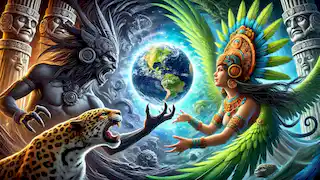
Part II: The Creation of the Worlds
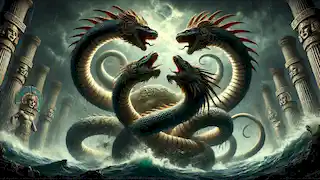
Part III: The Cycle of the Suns
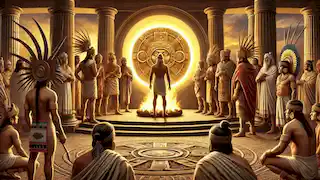
Part IV: The Fifth Sun and the Birth of Humanity
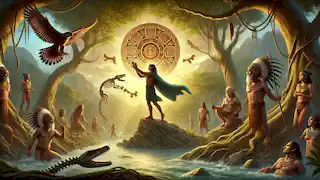
Part V: The Legacy of Ometecuhtli and Omecihuatl

















